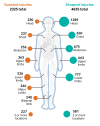Patterns of war related trauma in Gaza during armed conflict: survey study of international healthcare workers
- PMID: 40998470
- PMCID: PMC12462629
- DOI: 10.1136/bmj-2025-087524
Patterns of war related trauma in Gaza during armed conflict: survey study of international healthcare workers
Erratum in
-
Patterns of war related trauma in Gaza during armed conflict: survey study of international healthcare workers.BMJ. 2025 Oct 10;391:r2114. doi: 10.1136/bmj.r2114. BMJ. 2025. PMID: 41073084 No abstract available.
Abstract
Objective: To systematically document the patterns of war related injuries in Gaza, Palestine.
Design: Survey study of international healthcare workers, August 2024 to February 2025.
Setting: Gaza, Palestine.
Participants: 78 international healthcare workers deployed to Gaza.
Main outcome measures: The main outcome was the type of injuries observed by international healthcare workers during the conflict in Gaza. A Delphi informed survey was distributed through non-governmental organisation rosters and secure WhatsApp and email groups. Respondents completed the survey using contemporaneous logbooks and shift records.
Results: The survey collected data on 12 anatomical regions, mechanisms of trauma, and general medical conditions. 78 healthcare workers reported 23 726 trauma related injuries and 6960 injuries related to weapons. The most common traumatic injuries were burns (n=4348, 18.3%), lower limb injuries (n=4258, 17.9%), and upper limb injuries (n=3534, 14.9%). Explosive injuries accounted for most of the weapon related trauma (n=4635, 66.6%), predominantly affecting the head (n=1289, 27.8%), whereas firearm injuries disproportionately affected the lower limbs (n=526, 22.6%). Healthcare workers reported 4188 people with chronic disease across 11 domains requiring long term treatment.
Conclusion: Healthcare workers deployed to Gaza reported an injury phenotype defined by extensive polytrauma (≥2 anatomical regions), complex blast injuries from high yield explosives, firearm related injuries to upper and lower limbs, and severe disruption to primary care and the treatment of chronic diseases. The results provide actionable insights to tailor humanitarian response and highlight the urgent need for structured, resilient clinical surveillance systems.
Editor's note: This paper is based on research from an active war zone, where conventional research methods may be impossible to apply.
© Author(s) (or their employer(s)) 2019. Re-use permitted under CC BY-NC. No commercial re-use. See rights and permissions. Published by BMJ.
Conflict of interest statement
Competing interests: All authors have completed the ICMJE uniform disclosure form at www.icmje.org/disclosure-of-interest/ and declare: no support from any organisation for the submitted work; no financial relationships with any organisations that might have an interest in the submitted work in the previous three years; OA cofounded OxPal 2.0, an initiative supporting medical education in Palestine in partnership with consultants from the University of Oxford, Oxford, UK and other medical schools in the UK and USA. MQ is head of Emergency Medicine at Nasser Medical Complex, Gaza. AD is medical director of the David Nott Foundation, a British non-governmental organisation (NGO). DN is cofounder of the David Nott Foundation, a British NGO. AM previously served as head of Plastic and Reconstructive Surgery at Al Shifaa Hospital, Gaza. SK is founder and director of Mobile International Surgical Teams Foundation, a UK NGO. NMay is chairman of Medical Aid for Palestinians. ASC is an honorary patron of Medical Aid for Palestinians, a British NGO. OET, AG, MJS, AJe, AD, MM, VR, NMam, SK, NMay, DN, and ASC have volunteered on multiple medical missions worldwide, including in Gaza, with various NGOs. All authors declare no other competing interests.
Figures



References
-
- World Health Organization. Recommendations by the Director-General for improving health conditions in the occupied Palestinian territory, including East Jerusalem (WHA77/12). Geneva: WHO. 2024. Accessed 26 Jul 2025. https://apps.who.int/gb/ebwha/pdf_files/WHA77/A77_12-en.pdf
-
- United Nations Office for the Coordination of Humanitarian Affairs (UNOCHA). Reported impact snapshot. Gaza Strip (17 Sep 2025). 2025. Accessed 23 Sep 2025. https://www.ochaopt.org/content/reported-impact-snapshot-gaza-strip-17-s...
MeSH terms
LinkOut - more resources
Full Text Sources
Medical
Research Materials
